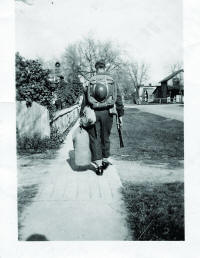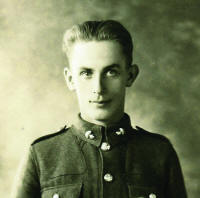Tage Agerbak
Tage was born in Odense, Denmark on April 30, 1916 and emigrated to Canada in 1927. The family found the move very difficult financially, as the country was just entering into the Depression. Tage was only able to attend school for two years at Gowancroft school along with his younger brother Ken and his two sisters, Anna and Margaret. He then had to join his older brother Buster working to help make ends meet. They took work wherever they could find it, in lumber camps, on farms and as a rigger on an oil rig.
It was while working on the John M. Fallis farm in the Wood Bay area that he met Rose Dupas of Pilot Mound. They married in 1937 and continued to work on the Fallis farm until the birth of their son Albert in December of 1938. At that time they moved with Tage's parents to Purves where he began work with an oil exploration company running a rig just outside of Purves. The local workers had agreed that they would be paid when the well "came in". Months later however, the oil company, having not found any oil, "stole away in the night" without paying the locals. Destitute, and with a family to support, Tage joined the army.
When Tage went to enlist in Winnipeg, as the story goes, he was asked for his place of birth. When he replied Odense, Denmark, the recruiter told him to go out, walk around the block and think about it. When he returned, he said he was born in Pilot Mound.
From the time he enlisted until the Grenadiers left for Bermuda and Jamaica in May of 1940, Tage seldom got home and didn't get to see his new daughter Blanche, born in March of 1940, until the few days leave he received in October of 1941, prior to sailing to Hong Kong.
Early in 1942, a telegram arrived at the local C.P.R. office stating that Tage was "missing in action". The station agent, Arthur German, said he couldn't "just send it over", so he called the Rev. MacDonald, the United Church minister to see if he would deliver it. As a young boy, I always remembered him as the man who made my mother cry. From then on, Rev. MacDonald's son Bruce and I became fast friends. This began many years of my mother's anguish. As word came back about some of the Grenadiers in prison camps, her hopes would rise, only to be crushed again when his name didn't appear.
At the end of the war in 1945, when the surviving prisoners and the dead had been accounted for, mother received a second telegram. It said that "Cpl.. Tage G. Agerbak has been declared missing in action and presumed dead".
After the grief, her long struggle to obtain her meager pension began. Due to the uncertainty of his death and the question of his nationality, the Government, with their forms to be filled out, were very slow to react. As the Grenadiers returned to Canada, Tage's demise could be ascertained with some certainty, and she finally received her pension, although she was never fully informed of how he died. The survivors of the prison camps rarely would discuss the incident, and when they did, they usually had a sanitized version of the events. If one goes to the Hong Kong Veterans web site there are 3 spread sheets. One lists all the Grenadiers who went to Hong Kong, a second listing those who died in prison camps with their cause of death, and a third listing of those killed or missing in action. If you look up Tage Agerbak, on the latter you will find him as "murdered by the Japanese along with the Mitchell brothers".
The Mitchell brothers were Lt. William Mitchell and Lt. Eric Mitchell of Winnipeg. Tage and one of the Mitchells were badly wounded and unable to retreat with the rest of their men as the Japanese closed in on them. The uninjured Mitchell brother stayed with his wounded comrades to see that they were treated properly. No one saw them again.
The National Film Board's documentary, Savage Christmas, tells the true unvarnished story of the battle in Hong Kong. In it they describe the battle of Wong Nei Cheong Gap, the only valley through the center of the island, and how the Grenadiers, out manned and out gunned, held the Japanese at bay for over four days. When the Japanese found out how few Canadian had held them off, their Commander was forced to apologize to his superiors. The Japanese soldiers were so angry, that any prisoner who was unable to march away was taken to a nearby gully and bayoneted, their bodies burned. British and Chinese archeologists have subsequently found some of their remains. A stone monument now marks the spot. Perhaps they were the lucky ones.
After the war, Rose remained in Pilot Mound to raise her two children, despite the urgings of Tage's relatives in Winnipeg to move there. She had her father's old shoe and harness shop moved from beside the Forresters' Hall to its present location. It now forms one half of T.J.'s Hair Design on Beverage Ave. Over the years she was able to add to it until it reached its current size. She began doing sewing jobs for the public in order to make ends meet. Eventually she was doing clothing alterations for the local merchants, created wedding dresses, made custom draperies with Jessie Harris and even did some furniture re-upholstering. Rose never remarried and was able to provide for two children alone.
In Rose's latter years, her pension was increased, allowing her to move
into a suite at Mound Estates. She often remarked that "now they raise
my pension when it's too late."
Of all the medals, plaques and commendations that she received over the years in Tage's name, she was proudest when she was finally able to afford a headstone bearing his name which was placed in the family plot in Greenway Cemetery. Even though his body wasn't there, she finally had a place at which to mourn.
Rose was pre-deceased by her daughter Blanche in early January 1998. Rose said that it seemed all her loved ones seemed to die during the Christmas Holidays. Rose passed away on September 18, 1999.
